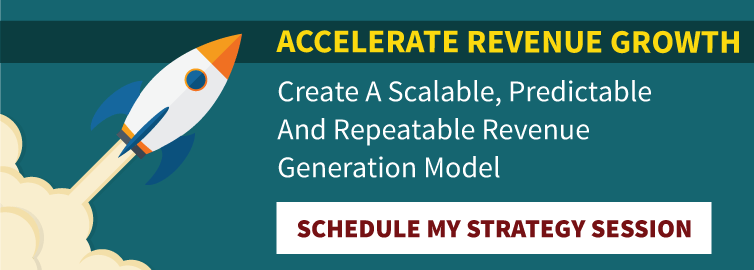
84% of Marketing Teams Are NOT on High-Performing Programs
Salesforce Research Uncovers Massive Underperformance Across Over 4,000 Companies Surveyed
-1.jpg?width=370&name=GettyImages-184878251%20(1)-1.jpg) I’ve always felt like a major disconnect existed between what CEOs were expecting from their investment in marketing and the actual performance of those marketing programs. This was mostly anecdotal, picked up from conversations with prospects and clients.
I’ve always felt like a major disconnect existed between what CEOs were expecting from their investment in marketing and the actual performance of those marketing programs. This was mostly anecdotal, picked up from conversations with prospects and clients.
But Salesforce recently published the fifth edition of its State of Marketing Report, which uncovered trends and insights from over 4,100 marketing leaders worldwide. The major insight was that only 16% of those surveyed said they had a high-performing marketing program.
This high performance was defined as being completely satisfied with their overall marketing performance and the outcomes of their marketing investments.
To me, that was both shocking and validating all in the same breath. Shocking in that I never expected the percentage to be so low, and validating in that as I’ve been saying for the last few years, driving revenue is more complex than ever before and requires so many moving parts that it’s like conducting a symphony orchestra day in and day out.
Here’s what I think is going on behind the scenes to make underperformance so rampant across so many companies.
Creating The Customer Experience Remains Challenging
It’s no longer conjecture or opinion; research from Salesforce’s State of the Connected Customer research shows that “80% of people say the experience a company provides is as important as its products and/or services.”
This signals a change in how marketing, sales and customer service get executed, and you should be looking at all three areas in your company. If you want to drive sustainable, scalable and predictable revenue growth, you’ll need to look hard at the customer experience across the buyer journey.
Today, we’re in the middle of the Fourth Industrial Revolution. As the World Economic Forum explains, “The First Industrial Revolution used water and steam power to mechanize production. The Second used electric power to create mass production.
“The Third used electronics and information technology to automate production. Now a Fourth Industrial Revolution is building on the Third, the digital revolution that has been occurring since the middle of the last century. It is characterized by a fusion of technologies that is blurring the lines between the physical, digital and biological spheres.”
Customers are no longer satisfied with just educational content. They are now demanding to be “known” and understood as individuals. We also live in a microwave economy where people are expecting immediacy in every aspect of their lives. They want the exact info they need at the exact time they need it.
According to Salesforce research, only 49% of marketing leaders believe they provide an experience completely aligned with customer expectations.
When they listed their top challenges and their top priorities, engaging with customers in real time was at the top of both lists.
These challenges are echoed in the research:
- Only 30% of marketers said they were completely satisfied with their ability to use customer data to create more relevant experiences.
- Only 29% of marketers said they were completely satisfied with their ability to deliver the right message on the right channel at the right time.
- Only 28% of marketers said they were completely satisfied with their ability to create a shared, single view of customers across multiple business units.
- Only 28% of marketers said they were completely satisfied with their ability to create personalized omni-channel customer experiences.
These numbers are alarmingly low.
It seems like marketing is the obvious choice to lead the customer experience initiatives, with 54% of high-performing marketing teams stating they are leading the customer experience initiatives across the entire business. But their ability to deliver remains challenging.
SOLUTION: It’s possible to work through these challenges if you focus on the people you’re trying to help. Gain a deep understanding of the issues that are driving their desire to have an experience with your company. Then make sure you fully understand their questions, challenges and issues while they’re interacting with you.
This allows you to map out their buyer journey based on their challenges. Solve for the prospect or customer. What do they want and/or need? What questions are they asking? How can you proactively service up answers before they ask? How can you personalize the experience?
Once you ask these questions, the execution gets much easier. Do you need a video here, or is a blog article, website page or whitepaper better? When should you reach out with an email? Did you get them subscribed to the blog? How can a webinar help you educate hundreds of people instead of just one?
The buyer journey becomes the map. Your marketing and sales execution are the tools. The data is the science that gets applied as the instructions on to how to apply the tools to the map. Create your first orchestrated customer buyer journey and then use the data to iterate over time based on performance data. In no time, the results will be better than anything else you’ve done.
Data Is The Backbone Needed To Create Experiences
One of the reasons the unified customer experience across marketing, sales and customer service remains so elusive is data. Only 47% of the marketers surveyed say they have a completely unified view of customer data across their organization.
Without this view, creating a remarkable and compelling buyer journey for your customers is going to be very challenging, which provides further fuel for why so few companies have figured this out.
In 2017, the median number of data sources used by marketing organizations was 10. In 2019, that number is up to 15, making the data management, cleansing and consolidation issues even more complex.
But getting the data clean, organized and consistent is only the first step in an increasingly complex task. Now that you have all of this data, what are you supposed to do with it?
Between multiple email addresses (Gmail and corporate), social activity, web activity, content downloads, multi-touch sales engagement and post-sale customer service engagement, almost all your contacts are logging tens to hundreds of touches before, during and after they make their purchase decisions.
How is anyone supposed to gain insights from all this data?
Now overlay the technology challenges and you find (at most companies) marketing automation owned by marketing, CRM owned by sales and customer service software owned by (you guessed it) customer service. This makes it almost impossible to create a seamless and well-orchestrated buyer experience based on data.
SOLUTION: Data is supposed to provide you insights into the performance of your marketing, sales and customer service. No longer are opinions, who has the loudest voice or who is the highest-ranking exec the most important input into decisions. The data should tell you what to do.
But data doesn’t always present insights on a silver platter. In fact, insights are almost always buried in the data. This is why most marketing, sales and service software rarely gives you insights but almost always gives you data.
They’re expecting you to find the insights in the data, and this is very hard to do. It takes years of execution and data analysis to uncover insights and then use those insights to drive recommendations and action plans that generate positive gains.
That’s why we created MAXG, an AI-powered insight and recommendation engine that learns what works for your company, your industry and your program. It then gives you the insights and recommendations that are so elusive and gives them to you in prioritized order based on your goals. It allows you to skip the dashboard entirely and jump right to working on what’s going to produce results.
According to Salesforce, AI in the customer buyer journey is still in its infancy, but those who are looking at AI tools to help them do more than personalization or automation are going to be the big winners.
Strategy Is Still Nonexistent In Most Mid-Market And Smaller Businesses
There is little or no mention of strategy in the Salesforce research. Our own research shows that over 80% of middle market and smaller companies start the year without a well-defined revenue strategy.
This means they’re simply trying different marketing tactics and running the same sales process they ran the previous year and hoping for a different outcome this year. You do know that’s basically the definition of insanity, right? You’re doing the same thing but expecting different results.
SOLUTION: Revenue growth strategy that includes marketing, sales and customer service has evolved quite a bit over the past few years.
It doesn’t take two months and tens of thousands of dollars anymore. Today, it can take a few days of intensive thinking to create a compelling and emotional buyer journey with disruptive messaging and the necessary touches to increase close rates and shorten the sales cycle.
How valuable would it be to have a map specifically created for your company, your industry, your revenue goals, your team and your current assets? How much would you pay for a map that laid out in clear steps exactly what you need to do to get to month-over-month revenue growth?
I know, it would be invaluable, and you’d pay anything to get this map. It would be like a map to the pot of gold hidden in the jungle for hundreds of years.
Working with partners who bring proven methodologies, practices and tested techniques to the table is the shortcut to get you to your revenue goals. Click here to schedule a discovery session with us, and we’ll talk to you about how we’ve accelerated almost every aspect of revenue growth for our clients.
How To Build A High-Performing Marketing Program
I love the definition of a high-performing marketing program, one that has business leaders completely satisfied with the overall performance and outcomes of their marketing investment.
There are a few elements in here worth unpacking. First, this eludes to the fact that they’ve defined, agreed and documented the overall performance metrics and business outcomes. Whatever they are, these companies are all clear on what they expected.
Next, it connects the agreed-on performance and business outcomes with a level of investment, meaning the people who approved the money also bought in and connected to the expected results. This might be ROI, but I think in more cases it’s about those business outcomes.
Understanding and agreeing on the business outcomes and aligning those with the appropriate level of investment is critical to today’s revenue generation and growth game. At Square 2, we align these two competing factors with our clients quarterly, and then we design the execution plans accordingly. This almost always ensures a high-performing program.
This doesn’t happen magically, but through this alignment we can create the strategy, tactics and analytics, and then leverage the appropriate technology to deliver the agreed-on business outcomes. It’s really the only way to create a high-performing program, and it’s also the reason so many companies don’t yet have that high-performing program they’re searching for.
The good news is that it’s a situation you can change with leadership, education and transparency associated with the desired outcomes and metrics. This provides the necessary insight to drive revenue growth in a scalable, repeatable and predictable way.

CEO and Chief Revenue Scientist
Mike Lieberman, CEO and Chief Revenue Scientist
Eliminate Hit-or-Miss Marketing Moves
Get advice, tips, tools and guidance to generate more leads for your company in this weekly email newsletter.



Eliminate Hit-or-Miss Marketing Moves
Get advice, tips, tools and guidance to generate more leads for your company in this weekly email newsletter.














